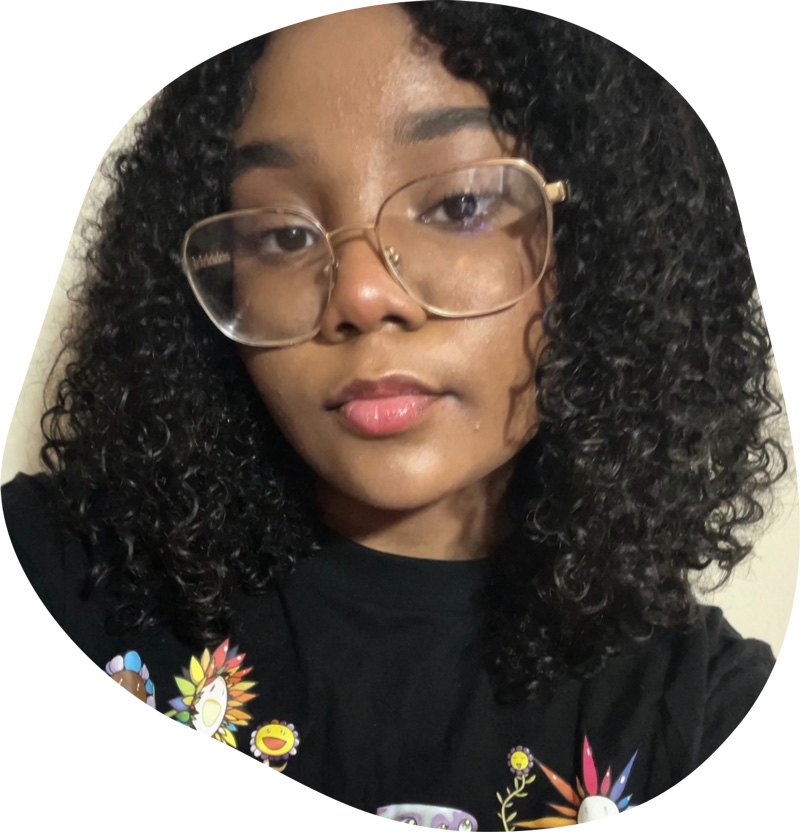
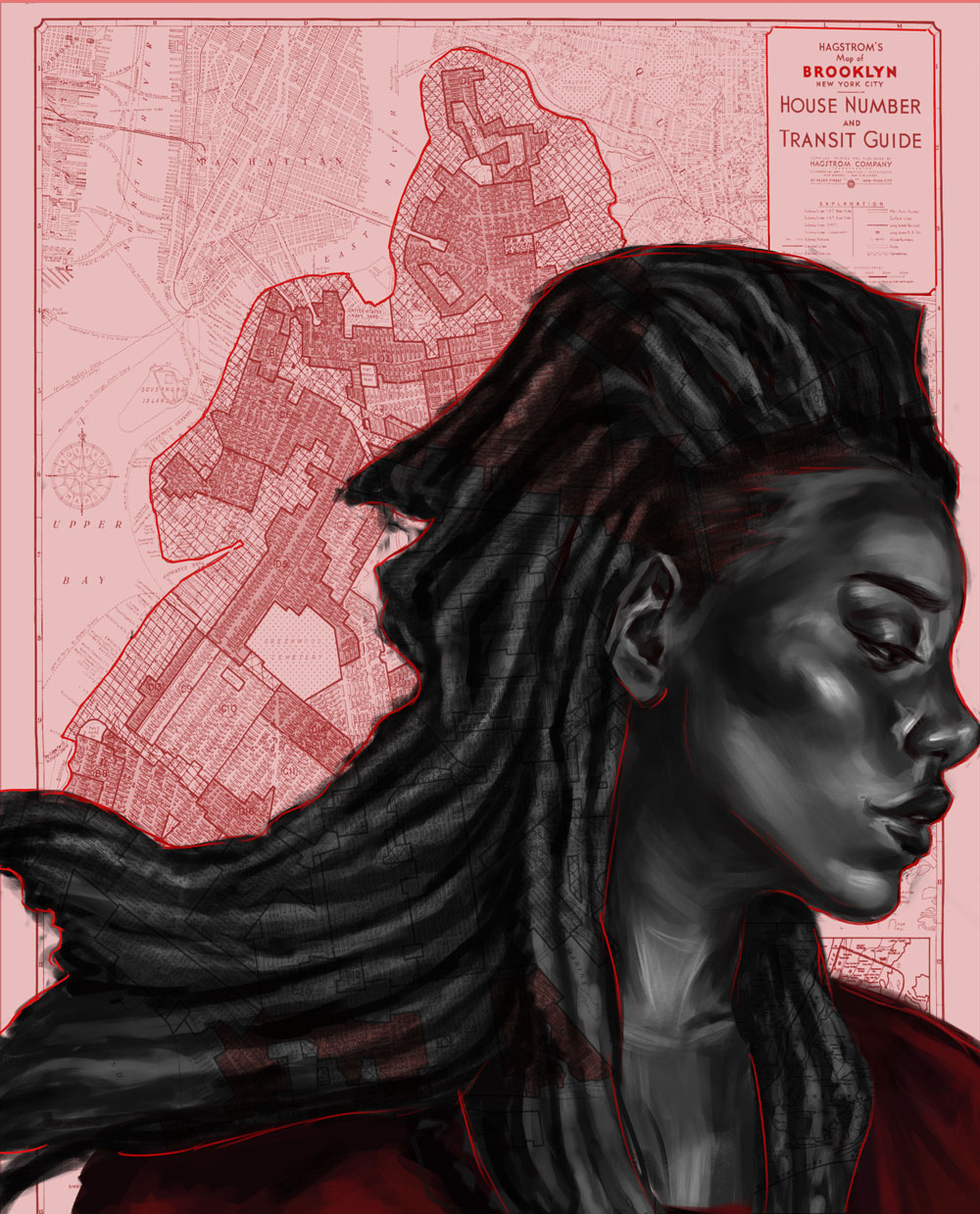
Loc’d Lines

Height: 18" x Width: 14" | Material(s): Digital painting (Procreate), iPad | Process(es): Altered redlining maps in background and in the figure's dynamic locs that resembles NY's map shape. | Citation(s): Brooklyn, New York HOLC Redlining Map April 1, 1938 | Idea(s): Black hair politics and redlining linked through systemic racism's economic impact on Black people | Curatorial Note: The dialogue between the powerful figure overlaid on the map image does a good job supporting their intent in a complex way.
Bianca Dundas
Student statement
Student statement
Does your work reference or draw on a contemporary or historical artmaking style, practice, or tradition? If so, please explain.
On the contemporary side, my work is inspired by the practice of social commentary through art, seen in artists like Kerry James Marshall and Kehinde Wiley, who use the human figure to confront narratives of Black identity and history.
Title of Artwork
The artwork is titled “Loc’d Lines,” a name that encapsulates the beauty, strength, and complexity of Black hair, especially locs. I’ve always been fascinated by how hair can hold so much history and identity—it’s not just about style but also representation of heritage, individuality, and self-expression that has often been scrutinized and politicized. With this piece, I connected that idea to redlining maps, layering them into the locs to symbolize how systemic racism has shaped Black communities. Locs, like the lines on those maps, carry weight—stories of struggle, survival, and care—so blending them felt like the perfect way to reflect my ideas about identity and oppression. The name “Loc’d Lines” came to me as I was deep into the process of creating the artwork. I thought about how locs are made: with time, patience, and intention—just like this piece. The “lines” not only refer to the shape of the locs but also the redlining maps in the background and within the figure. It’s all interconnected, much like how Black experiences are entwined into the larger history of this country. This work pushed me to explore more than I ever had before, both in terms of my artistic process and the meaning behind it. It’s personal to me as someone from Brooklyn, a place directly shaped by these histories, but I also wanted to honor that history while celebrating the perseverance of Black identity.


My life has been complex with living within historic oppressive structures but also having pride, love, and community. How do I utilize Black bodies as subject matter and the color red to create a more nuanced understanding of contemporary Black identity?
What did you do to improve your 2-D, 3-D, or Drawing portfolio skills?
I had to consistently challenge myself to take risks and explore new methods. I began experimenting with layering, composition, and symbolism, which really pushed me to think beyond the basics. Specifically, in Loc’d Lines, I utilized digital tools in Procreate that I previously overlooked. I would typically treat digital art the same as traditional painting, but this piece compelled me to explore blending tools, color modes, and even unconventional ideas I initially thought were "stupid." Layering, in particular, was a skill I consistently practiced, allowing my works to develop depth and cohesion over time. I embraced trying various solutions and learning from mistakes until a solution is found.
Describe the critique practices and feedback you received in AP Art and Design.
Class critiques were a core part of the process. Critiques were super collaborative and focused. Instead of just saying, “I like this,” we highlighted what was working and what could be improved. Sharing my work and hearing how my classmates interpreted it really helped me see if my ideas were coming across the way I intended. The feedback was always honest but supportive, and it pushed me to think more critically about my choices and how I could refine them. I felt very validated, and I gained the determination to take risks with my work going forward.
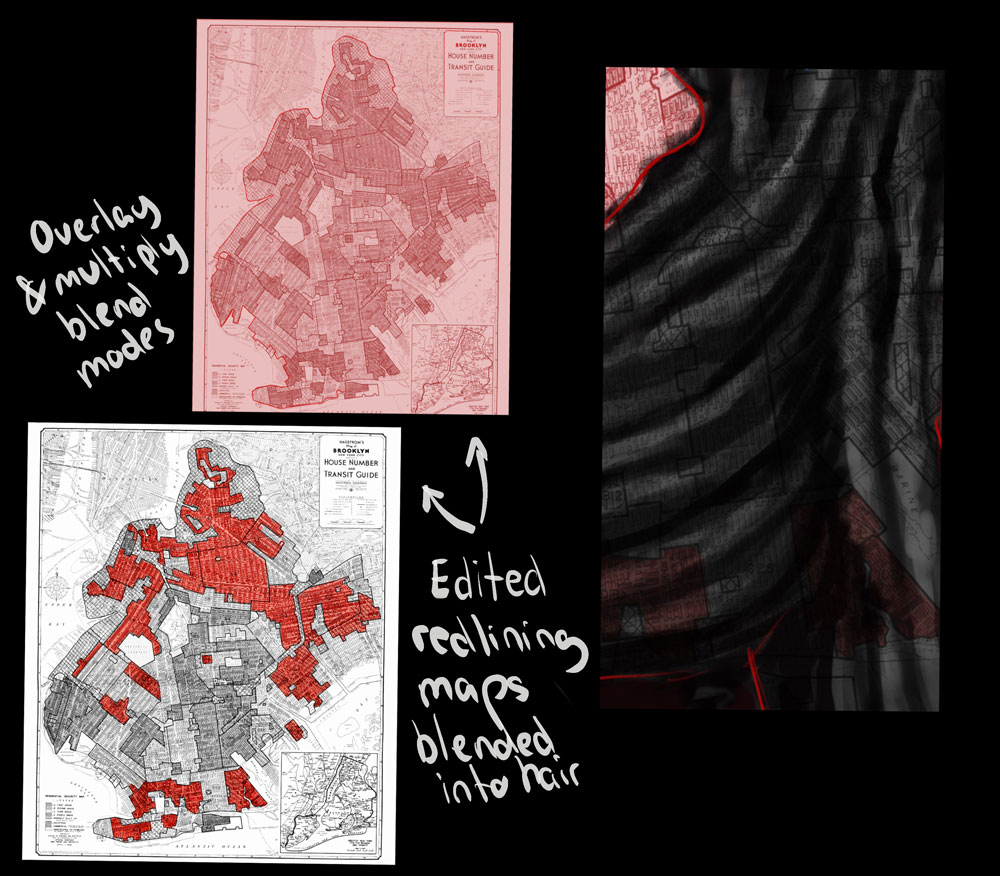
Material(s): Digital painting | Process(es): Used various blend modes on Procreate to edit redlining maps and camouflaged into locs | Idea(s): Black hair politics and redlining linked through systemic racism's economic impact on Black people | Curatorial Note: Helpful to see the source material.
In what ways did your artmaking confidence increase in AP Art and Design?
My sustained investigation reflected ideas, experiences, and emotions that are deeply personal to me, and I initially worried about how to communicate them effectively. AP Art taught me that experimentation isn't failure—it’s part of growth. At the start of the year, I was hesitant to take risks in my art. I stuck to what I knew: simple portraits. I learned to trust the process, even when I didn’t have a clear answer right away. I spent hours messing with the composition, trying new approaches, and even scrapping ideas I initially loved. What felt like wasted time at first actually led to discoveries that elevated the work. The more I experimented—whether with poses, layering, or blending symbolism—the more I realized that mistakes were stepping stones to stronger pieces. I could create meaningful, conceptual work that honors my visions no matter how challenging the process might seem.
How did you modify or revise your artmaking direction based on feedback?
I approached each piece with the understanding that my first idea would almost never be my final. I made it a habit to take note of every thought, idea, and piece of feedback I received from my teacher and my peers. I sketched out new ideas while modifying and revising, never forgetting that I could turn to my art teacher for help at any time.
How did your classmates help you in the creative process?
My classmates were truly helpful in the creative process. They always offered fresh perspectives that helped me catch details I might have overlooked and often inspired me to approach challenges in new ways. Their constructive feedback pushed me to think outside the box and refine my work in ways I couldn’t have done alone.
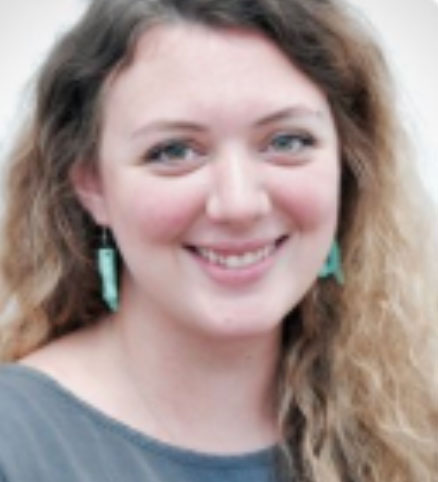
Samantha Davis
Content Lead and Art Teacher
Coney Island Preparatory High School, Brooklyn, NY, USA
Teacher statement
Teacher statement
The AP Art and Design course supports inquiry-based personalized learning in the sustained investigation portfolio component. What strategies helped you guide students through inquiry?
Instead of focusing on contemporary artists’ singular works, we examine their entire bodies of work, often comparing different periods from the same artist to tease out distinctions between style and approach. We read numerous interviews with contemporary artists to understand how artistic voices and priorities evolve. We also cross-examine artists who explore similar subject matter and materials but employ different concepts and approaches, highlighting differences in conceptual layering and design choices. Throughout the year, we methodically document every stage of the art-making process, providing students with insights into each artistic choice they make. After completing each artwork, students engage in an inquiry reflection designed to capture their metacognitive understanding and process. As a class, we critique three works from each student at a time, rather than singular works, so students receive feedback that addresses their ongoing inquiry and aesthetic trends. One-on-one peer critiques of individual works are always conducted mid-process, encouraging students to intentionally incorporate collaboration as a key part of their creative development.
How did you scaffold writing into the art-making and thinking processes?
At the start of the year, we begin with freewriting and journaling. Writing is assessed for clarity, fluency, and specificity. We create concept maps that we build upon throughout the year, and we regularly engage in short bursts of writing to synthesize process and idea brainstorming. I prioritize clarity of thought and word choice over endurance writing. We read a variety of contemporary artist statements, including my own. I share my work and artist statements, inviting students to ask questions about my metacognitive process. I also narrate my decisions and priorities, modeling how to articulate connections between ideas, processes, and materials. This approach has significantly improved students' ability to recognize and articulate these connections in their own work.
How did you support skill development AND inquiry in the AP Art and Design curriculum?
During the first half of the year, my feedback is technical and scaffolded to support the development of students' approach. Skill development requires time and experimentation, so my focus is on building a strong foundation. As students' techniques and clarity in experimentation and refinement improve, I shift my priorities toward conceptual development within their inquiries. Each unit introduces a new lens for thinking about art making, ensuring that the ethos of each unit fosters a fresh approach to inquiry while remaining grounded in contemporary art practices. The second half of the curriculum is primarily dedicated to individualized coaching, with a focus on both skill development and conceptual inquiry.
How did you structure practice, experimentation, and revision into your AP Art and Design curriculum?
I supplement inquiry-based assignments with metacognitive practices and tasks that help students audit their skills and ideas. Direct observational assignments challenge students to approach their work from new perspectives, with prompts that prioritize experimentation with materials and techniques. As the course progresses, prompts become more focused on experimentation directly related to their inquiry, followed by a second prompt aimed at driving refinement. Students develop a concrete understanding of refinement by establishing their own criteria for success through experimentation and practice. After they have completed about 50% of their portfolio, we review their body of work to identify areas for refinement, as well as strengths and weaknesses. This tends to be a pivotal moment for students, as they are able to visualize the remainder of their portfolio with greater clarity and intention.
How do you support your students in the Selected Works portfolio component?
I trust that my students know their own work. We don't focus on selecting specific works until much later, once they have a deeper understanding of their body of work. At that point, we evaluate which pieces best represent their inquiry. When choosing works, we discuss how each piece contributes to a holistic understanding of the major conceptual themes, techniques, and processes. Students often gravitate toward technically strong pieces, so we conduct an audit of their top six to seven choices, evaluating the merits of each work in a comprehensive, well-rounded manner.
What formative and summative assessments helped guide your students through your AP Art and Design curriculum?
Each piece in the inquiry serves as a summative assessment. Formative assessments include initial brainstorming, developing a research question, planning with evidence of practiced compositions and processes, and completing an inquiry reflection after each artwork. For every inquiry piece, students write a research question and, following the summative, complete an inquiry reflection. The inquiry reflections are compiled in a single ongoing document, with a new reflection added after each completed work. In these reflections, students revisit all stages of development, considering how their research and exploration influenced the final outcome of their summative piece.
What creative programming (i.e., exhibit spaces, mentoring programs, curricular supports) have you implemented to support AP Art and Design students?
Creative programming is my approach to individualized coaching and an effort to provide alternative curricular support beyond artwork. I’ve found that exposure to diverse perspectives and broadening students' worldviews can be profoundly transformative. To facilitate this, I offer books from my personal library on philosophy, art-making, politics, culture, and more. For each summative, I provide students with curated research lists. These lists include biographies, philosophical debates, historical texts from critical theorists, readings on liberation methodologies, poetry, graphic novels, performance art, and a range of artists connected to their inquiry. I also share my own artwork, guiding students to deconstruct my inquiry by analyzing my ideas, design choices, and processes.
What did you learn from working with your student?
Bianca is brilliant, diligent, and relentless in her exploration. Her approach is thoughtful and precise, as she strives to keep her work balanced while demonstrating a deep understanding of the power of aesthetics. Bianca has taught me a great deal about the digital medium, especially through her drive to push the limits of digital painting. In 'Loc’d Lines', Bianca and I had extensive discussions about overlay and opacity. We debated how the digital medium could serve as a means of painting beyond traditional acrylic and oil. Her reflections revealed an inventive and exciting approach to expression in paint, emphasizing the importance of wielding digital technology as a vital tool for her growth as a young artist.

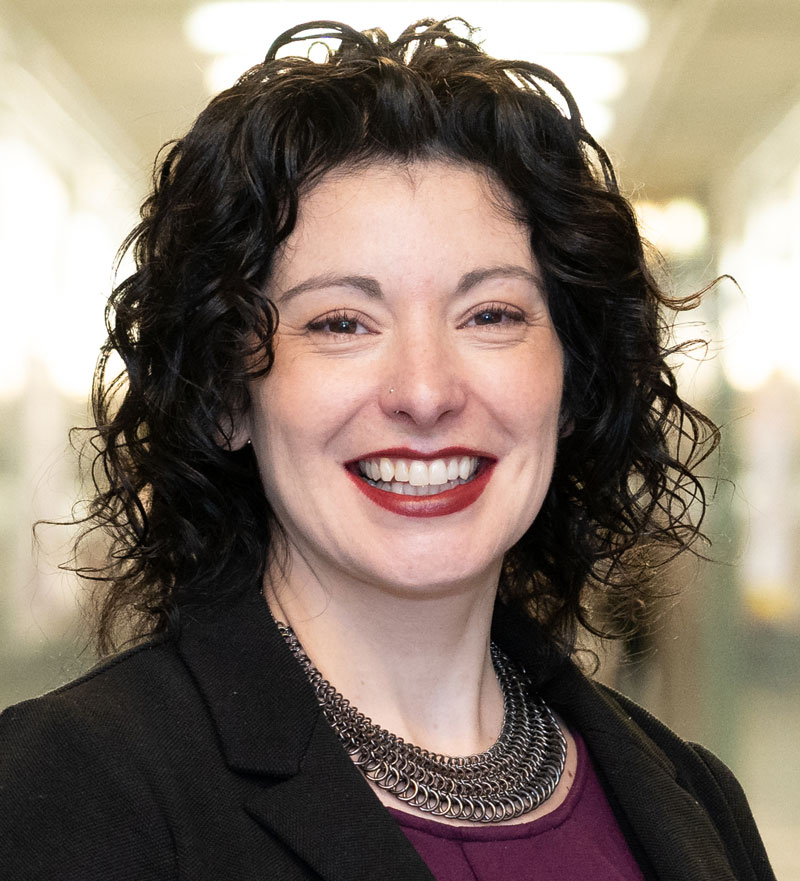
Christy Frembes Boise
Coney Island Prep High School, Brooklyn, NY, USA
Principal
Leader Statement
Leader Statement
What are you most proud of regarding your school’s AP Art and Design program, student, and teacher?
Our AP Art and Design program provides a beautiful opportunity for scholars to hone their talents exploring new techniques and methods in art making, refining skills in methods they are proficient in, and most importantly exploring themselves and the world around them. Art teacher Samantha Davis is in her ninth year at CIP, and she has worked to build a program from the ground up. She has offered development to other teachers at our school ensuring alignment driving toward a unified goal of empowering students and offering them exciting opportunities to pursue art making. I could not be more proud of her, her students, and what they've accomplished.
What do you do to support visual arts programming in your school?
Ms. Sam Davis is both our AP Art teacher and our content team leader. I meet with her weekly to track progress, discuss upcoming events and deadlines, and determine how the teachers on the team and their students are doing. My expertise is not in the arts, and I rely heavily on Ms. Davis’s knowledge. I value her opinions and listen with an open ear. I do my best to advocate for the team's facilities, budget, and curricular needs. Centering student choice and voice is important to me, and offering a variety of course pathways is part of that. And then of course, one of my favorite parts of my job is having the opportunity to celebrate successes with our teachers and students.
What is your advice to other school leaders on how to support an AP Art and Design program?
Communicate with your teachers frequently, listen to their needs, and provide as best you can. Though my expertise is not in the arts, I consider myself a thought partner for our content team leader of art. She values my advice and I value hers! Get into your art classrooms as frequently as you do your math and English classrooms. Show them you value their work. This is of course a bit oversimplified, but by and large, I have found that our teachers are passionate, caring professionals and when they have the tools they need, they will wow you with the results.

Bianca Dundas


